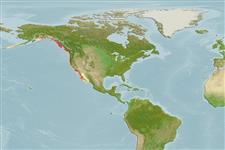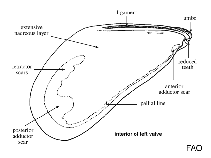Mytilus californianus Conrad, 1837
California mussel| Native range | All suitable habitat | Point map | Year 2050 |

|
| This map was computer-generated and has not yet been reviewed. |
| Mytilus californianus AquaMaps Data sources: GBIF OBIS |
Google image | No image available for this species;
drawing shows typical species in Mytilidae.
Classification / Names ชื่อสามัญ | ชื่อพ้อง | CoL | ITIS | WoRMS
Bivalvia | Mytilida | Mytilidae
Environment: milieu / climate zone / ระดับความลึก / distribution range นิเวศวิทยา
; ระดับความลึก 0 - 100 m (อ้างอิง 95344), usually 0 - 30 m (อ้างอิง 104320). Temperate; 62°N - 18°N, 180°W - 109°W
Distribution ประเทศต่างๆ | พื้นที่จำแนกตาม FAO | ระบบนิเวศหลายระบบ | การปรากฏขึ้น,การเกิดขึ้น,พบ | การแนะนำ
Eastern Pacific: from Aleutian Islands, Alaska, USA to Baja California and Isla Socorro, Mexico. Subtropical to boreal.
Length at first maturity / ขนาด / Weight / Age
วัยเจริญพันธุ์: Lm ? range ? - ? cm Max length : 25.5 cm TL เพศผู้/กระเทย; (อ้างอิง 95344); common length : 20.0 cm TL เพศผู้/กระเทย; (อ้างอิง 312)
Short description สัณฐานวิทยา
Life cycle and mating behavior วัยเจริญพันธุ์ | การสืบพันธุ์ | การวางไข่ | Eggs | ความดกของไข่ | Larvae
Main reference
อ้างอิง | ผู้ประสานงาน | ผู้ร่วมมือ
Gallivan, G. and J. Danforth 1999 Phylum Mollusca. Marine Science Institute. Http://216.239.51.104/search?q=cache:EEiLeA0OeAMJ:www2.ucsc.edu/simp/guide.pdf+Nuttalina+californica&hl=tl&gl=ph&ct=clnk&cd=8 [accessed 20/01/06] (อ้างอิง 312)
IUCN Red List Status
(อ้างอิง 130435: Version 2025-1)
CITES status (อ้างอิง 108899)
CMS (อ้างอิง 116361)
Threat to humans
Human uses
การประมง: การค้า
| FishSource | ทะเลรอบๆเรา
เครื่องมือ
ข้อมูลเพิ่มเติม
Max. ages / sizes
Length-weight rel.
Length-length rel.
Length-frequencies
Mass conversion
อุดมสมบรูณ์
แหล่งที่มาจากอินเตอร์เน็ต
BHL | BOLD Systems | CISTI | DiscoverLife | FAO(Publication : search) | Fishipedia | GenBank (genome, nucleotide) | GloBI | Gomexsi | Google Books | Google Scholar | Google | PubMed | แผนภูมิชีวิตแบบต้นไม้ | Wikipedia (Go, ค้นหา) | บันทึกทางด้านสัตววิทยา



